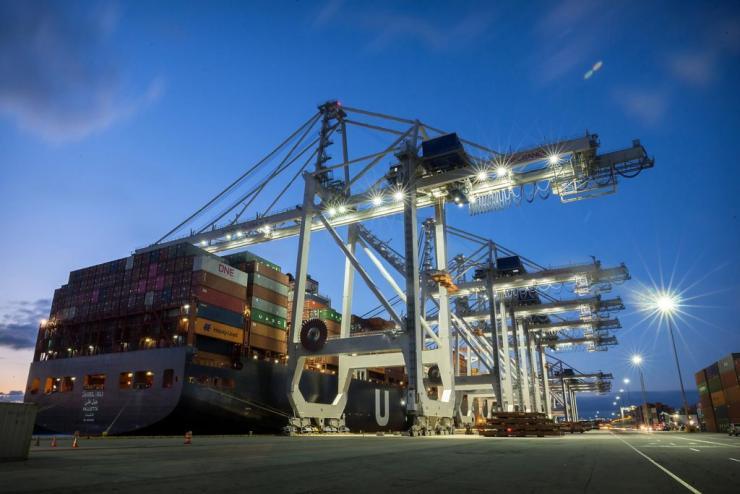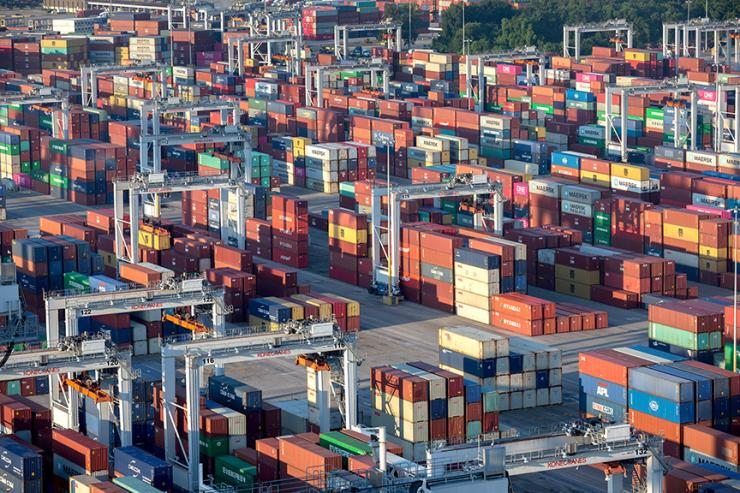Why Restarting the Global Economy Won't be Easy
May 10, 2020 — Atlanta, GA

The U.S. gets close to a trillion dollars of products annually from Asian countries, and most are shipped by sea, which requires a four-to-six-week lead time. Here, a ship is docked at a Georgia Ports Authority facility in Savannah. (GPA Photo: Stephen B. Morton)
As the world contemplates ending a massive lockdown implemented in response to COVID-19, Vinod Singhal is considering what will happen when we hit the play button and the engines that drive industry and trade squeal back to life again.
Singhal, who studies operations strategy and supply chain management at the Georgia Institute of Technology, has a few ideas on how to ease the transition to the new reality. But this pandemic makes it hard to predict what that reality will be.
“We know pandemics can disrupt supply chains, because we’ve had the SARS experience, but this is something very different,” said Singhal, the Charles W. Brady Chair Professor of Operations Management at the Scheller College of Business, recalling the SARS viral pandemic of 2002 to 2003. But that event did not have nearly the deadly, worldwide reach of COVID-19.
“There is really nothing to compare this pandemic to,” he said. “And predicting or estimating stock prices is simply impossible, unlike supply chain disruptions caused by a company’s own fault, or a natural disaster, like the earthquake in Japan.”
For more coverage of Georgia Tech’s response to the coronavirus pandemic, please visit our Responding to COVID-19 page.
The earthquake that shook northeastern Japan in March 2011 unleashed a devastating and deadly tsunami that caused a meltdown at a nuclear power plant, and also rocked the world economy. It was called the most significant disruption ever of global supply chains. Singhal co-authored a study on the aftereffects, “Stock Market Reaction to Supply Chain Disruptions from the 2011 Great East Japan Earthquake,” published online in August 2019 in the journal Manufacturing & Service Operations Management.
But COVID-19 represents a new kind of mystery when it comes to something as complex and critical to the world’s economy as the global supply chain, for a number of reasons that Singhal highlighted:
- The global spread of the virus and duration of the pandemic. “We have no idea when it will be under control and whether it will resurface,” Singhal said. “With a natural disaster you can kind of predict that if we put in some effort, within a few months we can get back to normal. But here there is a lot of uncertainty.”
- Both the demand and supply side of the global supply chain are disrupted. “We’re not only seeing a lot of factories shutting down, which affects the supply side, but there are restrictions on demand, too, because you can’t just go out and shop like you used to, at least for the time being,” he said. “And all this is taking place in an environment where supply chains are fairly complex – intricate, interconnected, interdependent, and global.”
- Longer lead times. “We get close to a trillion dollars of products annually from Asian countries, about $500 billion from China,” Singhal said. “Most are shipped by sea which requires a four-to-six-week lead time. The fact that logistics and distribution has been disrupted and needs to ramp up again will increase lead time. So, it will take time to fill up the pipeline, and that is going to be an issue.”
- Supply chains have little slack, and little spare inventory. While manufacturing giants such as Apple, Boeing, and General Motors have more financial slack to carry them through a massive economic belt tightening, their suppliers, spread out across the globe, come in different sizes, different tiers, “and these smaller companies don’t have much financial slack,” said Singhal, pointing to a report of small and medium sized companies in China, “which have less than three months of cash. They’ve already been shut down for two months, and cash tends to go away quickly.
“Many of these companies may go bankrupt,” he added. “So we need to figure out how to reduce the number of bankruptcies. Government is going to play an important role in this, and the stimulus package the U.S. has approved will be helpful.”
Trying to get a handle on how stock markets are responding to all that has happened is like trying to take aim at a moving target during a stiff wind. Volatility has increased significantly since February 13, when the Dow Jones index reached an all-time high of about 29,500.
“That’s because we did not expect the pandemic to spread and disruptions initially were low because of pipeline inventory,” Singhal said, noting that since then the Index dropped sharply, to 18,500 on March 23 (a decline of nearly 38 percent), it picked up and was back to 22,000 by March 30. “The same is true of other stock markets. The Chinese stock market was down 13 percent, but they seem to have the pandemic under control.”
While COVID-19 is making it difficult to predict what the market will look like, Singhal has some ideas of which industries will be most affected.
“Travel, tourism, entertainment, restaurants – businesses that rely on people going out—will take a long time to recover, in terms of profitability and stock price, even once the pandemic is contained,” he said. “People are going to be hesitant to travel after all this. Tourism will take a hit.”
Essentials like groceries are surging as people stock up in reaction to being shut in, but this isn’t a long-term trend. Singhal doesn’t expect this trend to continue as shopping habits and store shelves eventually normalize.
Companies that sell basics, with a strong online presence, will do well, “but industries like automobiles and electronics, which have global supply chains and have a hard time replacing specialized, high-tech components will be affected,” said Singhal, who also has suggestions on the most important issues to address and how to help speed up the recovery and bring supply chains back to normal (or whatever normal looks like after this):
- The ability to bring capacity online, especially for small and medium-sized companies. “Facilities and equipment may need some time to restart,” he said. “Staffing is a big issue. How quickly can you get people back to work? Also, can you get the raw materials and build up the inventory to support production? That may be tough when pent up demand is being released and everybody is competing for limited supplies.”
- Distribution. Lead times already are long, he notes, and a sudden increase in demand for logistics and distribution services as everybody ramps up again could extend lead times.
- Prevent bankruptcies. Government programs need to be established (like the U.S. stimulus package) to keep small- and medium-sized firms in business. This concern extends to second- and third-tier suppliers, and large firms like Apple or Boeing or GM, should do the same for their most critical suppliers.
- Build slack. “Preserve cash, get new lines of credit or draw down lines of credit, maybe cut dividends or stock repurchases,” Singhal said. “And build inventories of critical components.”
Singhal also stresses the need for transparency, up and down the supply chain: “What that means is, companies need to have a good understanding of what is happening to their customers and suppliers, but not just their immediate, first tier customers and suppliers, but also their customers and suppliers, and so on up and down the line.”
It will be very important going forward for the next several months to monitor the health of the supply chain from both the customer perspective and a supplier perspective, because this is a new world, says Singhal, who adds an optimistic postscript, “It’s a crisis situation now, but I think we can put it back together.”
Research News
Georgia Institute of Technology
177 North Avenue
Atlanta, Georgia 30332-0181 USA
Media Relations Assistance: John Toon (404-894-6986) (jtoon@gatech.edu).
Writer: Jerry Grillo

The U.S. gets close to a trillion dollars of products annually from Asian countries, and most are shipped by sea, which requires a four-to-six-week lead time. Here, containers are stacked at a Georgia Ports Authority facility in Savannah. (GPA Photo: Stephen B. Morton)

Vinod Singhal is the Charles W. Brady Chair Professor of Operations Management at the Scheller College of Business at Georgia Tech. (Georgia Tech Photo)
John Toon
Research News
(404) 894-6986




